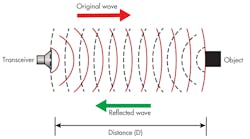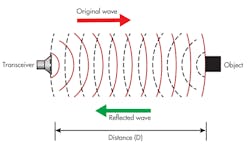Ultrasonic Sensors Measure Up in Home-Automation Applications (.PDF Download)
Ultrasonics or ultrasound is a radar-like system that uses ultrasonic signals at frequencies above those typical for human hearing, usually above 16 to 20 kHz. The 40- to 70-kHz range tends to be most popular. Its main application is object detection and distance measurement.
Ultrasonic sensors are already widely used in automotive applications and a variety of industrial applications. Now, though, new potential applications are being discovered in the home-automation market.
How It Works
Ultrasonic object detectors work like radar. A transceiver consisting of a transmitter transducer radiates a signal toward a target. That target reflects or echoes the signal back to the transducer receiver at the source (Fig. 1). These transducers are usually of the piezoelectric type, with 58 kHz being a common signal frequency.
1. Ultrasonic sensing works like radar. A radiated signal is echoed back, and the time of transit is measured. The distance is then computed based on the speed of sound in air.
The ultrasonic transceiver measures the time that it takes for the signal to travel out to the target and back. Then, knowing the speed of sound in air and the transition time, the distance between transmitter and remote object can be calculated:
D = 1120(T)
where D is the distance out to and back from the target; T is the transition time; and 1120 is the speed of sound in air in feet per second. That speed varies somewhat with temperature and other environmental factors, but is a good indicator of distance. Since the signal must travel out to the target and then back to the source, the actual distance between the two is one half of D.

